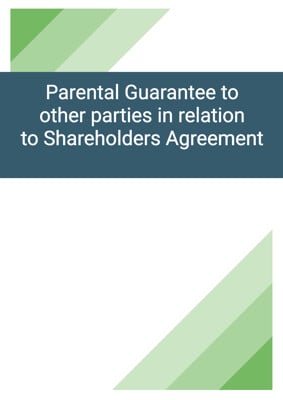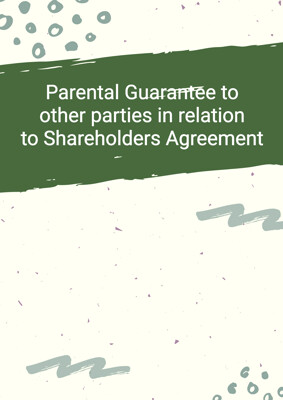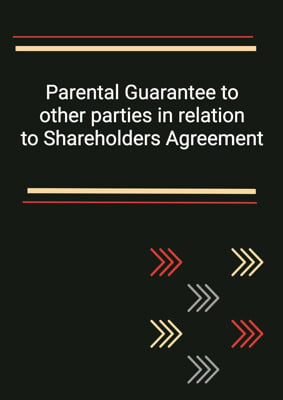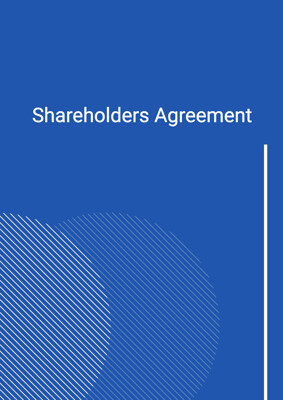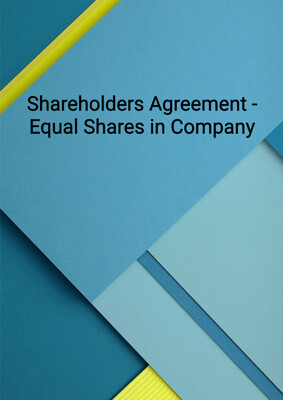How to Tailor the Document for Your Need?
01
Create Document
Fill in the details of the parties. You can click the "Fill with Member’s Information" button to complete it with information saved to your account.
02
Fill Information
Please fill in any additional information by following the step-by-step guide on the left hand side of the preview document and click the "Next" button.
03
Get Document
When you are done, click the "Get Document" button and you can download the document in Word or PDF format.
04
Review Document
Please get all parties to review the document carefully and make any final modifications to ensure that the details are correct before signing the document.
Document Preview
Document Description
The Shareholders Agreement is a legally binding document that outlines the terms and conditions governing the relationship between the shareholders of a company. It is entered into by Party 1, Party 2, and Party 3, who have agreed to jointly invest in a company. The purpose of this agreement is to set out the terms governing their relationship as shareholders in the company.
The agreement begins with an interpretation section, which defines various terms used throughout the document. It includes definitions for accounting principles, directors, business day, business plan, chairman, chief executive, company, shareholders, shares, subsidiary, and more.
The agreement then proceeds to outline the purpose of the company, which is to carry out the business described in clause 2. The business of the company is to be conducted in the best interests of the company in accordance with the general principles of the business plan approved by the parties.
Next, the document describes the characteristics of the company, including its name, registered office, authorized share capital, and initial directors, chairperson, chief executive, and secretary.
The agreement also covers capital and further finance, specifying that the company's issued share capital may be increased with the agreement of the parties. It states that the parties do not have an obligation to contribute further funds or participate in any guarantee or similar undertaking for the company's benefit.
The board and management section outlines the responsibilities of the board of directors, including the overall direction, supervision, and management of the company. It specifies the composition of the board and the quorum required for board meetings. It also sets out the notice and agenda requirements for board meetings.
The reserved matters section defines certain matters that require the prior approval of the parties, such as altering the memorandum and articles, changing the share capital, changing the nature of the business, and approving any transactions with a party's group. It outlines the method of approval by shareholders and the quorum and voting requirements for general meetings.
The financial matters section covers accounting principles, auditors, and the company's financial year. It also addresses information and reporting requirements, including the supply of audited accounts, business plans, and budgets.
The confidentiality section imposes obligations on the parties to keep confidential any information relating to the company's customers, business, assets, or affairs. It sets out exceptions to the confidentiality obligation, such as disclosures to professional advisers and disclosures required by law or regulatory authorities.
The non-competition section prohibits the parties from competing with the company in the business. It includes exceptions for investments in listed companies and activities that contribute less than a certain percentage of annual sales.
The regulatory matters section requires the parties to co-operate in providing information and to discuss any material regulatory action. It also addresses co-operation in relation to any notifications or filings required under this agreement.
The relationship with the party's group section requires contracts between the company and members of a party's group to be made on an arm's length commercial basis. It also addresses claims by the company against a party arising from agreements with members of that party's group.
The tax matters section requires the parties to co-operate in connection with taxation returns, claims, or elections. It sets out the party's obligations in relation to the taxation affairs of the company group.
The transfer of shares section outlines the restrictions on transferring shares and the process for transferring shares between the parties or to third-party purchasers. It includes provisions for the continuing party to purchase shares in certain circumstances and for the drag-along right if a majority of shares are sold to a third party purchaser.
The termination events section specifies events that would constitute a termination event, such as the dissolution or administration of a party or the appointment of a liquidator or receiver. It sets out the rights and obligations of the parties in the event of a termination event.
The default section allows for one party to serve notice on the other party in the event of a breach of the agreement. It requires the defaulting party to stop the breach and make good the results of the breach within a specified period.
The transfer terms section sets out the terms for the transfer of shares, including the sale of shares free from liens and encumbrances, the assumption of obligations by the buyer, and the completion process.
The parent company further assurances section requires each party to exercise all voting rights and powers available to it to ensure the provisions of this agreement are fulfilled. It also requires each party to ensure its group companies perform their obligations under this agreement.
The remaining sections of the agreement cover non-assignment, waiver of rights, amendments, invalidity, no partnership or agency, announcements, costs, entire agreement, conflict with articles, notices, settlement of disputes, counterparts, and no rights for third parties.
This Shareholders Agreement is governed by the laws of the territory and any disputes arising under this agreement shall be subject to the exclusive jurisdiction of the courts of the territory.
How to use this document?
To use this Shareholders Agreement, follow these steps:
1. Review the entire agreement to understand its terms and conditions.
2. Ensure that all parties involved in the agreement have a clear understanding of their roles and responsibilities as shareholders.
3. Make sure that the company's memorandum and articles of association are in the agreed form.
4. Establish the company in the territory with the specified characteristics, including its name, registered office, and initial directors, chairperson, chief executive, and secretary.
5. Determine the authorized share capital of the company and the process for issuing new shares.
6. Agree on the business plan and budget for the company, ensuring that it aligns with the best interests of the company.
7. Establish the board of directors and define their responsibilities and decision-making process.
8. Identify the reserved matters that require the prior approval of the parties and establish the method of approval.
9. Adopt accounting principles for the company's financial statements and appoint auditors.
10. Establish information and reporting requirements, including the supply of audited accounts, business plans, and budgets.
11. Ensure that all parties maintain confidentiality of any sensitive information related to the company's customers, business, assets, or affairs.
12. Comply with the non-competition clause and refrain from engaging in any business that competes with the company.
13. Co-operate with each other in relation to any regulatory matters and provide all necessary information for notifications or filings.
14. Ensure that contracts between the company and members of each party's group are made on an arm's length commercial basis.
15. Comply with tax obligations and co-operate in making any necessary returns, claims, or elections.
16. Adhere to the restrictions on transferring shares and follow the process outlined in the agreement for transferring shares between the parties or to third-party purchasers.
17. In the event of a termination event, follow the specified procedures for resolving disputes and transferring shares.
18. Exercise voting rights and powers to ensure the provisions of the agreement are fulfilled.
19. Keep all parties informed of any changes to contact details or other relevant information.
20. Seek legal advice if needed to ensure compliance with the agreement and applicable laws.
Please note that this guidance is for informational purposes only and does not constitute legal advice. It is recommended to consult with a legal professional to ensure compliance with all legal requirements and to address specific circumstances related to the Shareholders Agreement.
Not the right document?
Don’t worry, we have thousands of documents for you to choose from:

